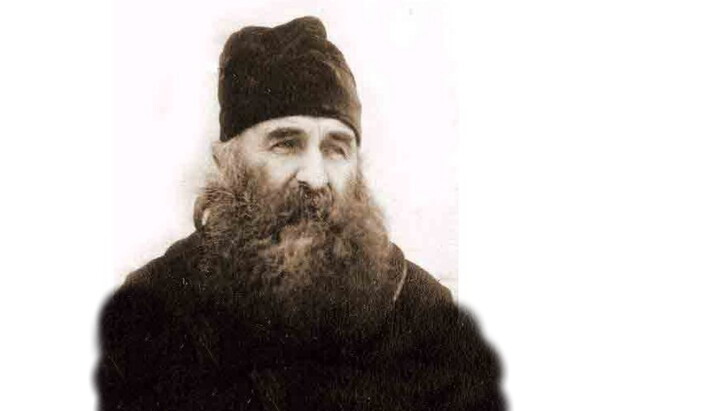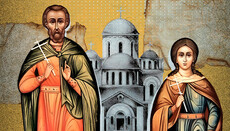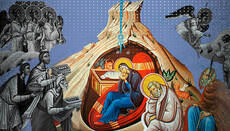New martyrs of the 20th century: Hieromartyr Damaskin of Hlukhiv

Bishop Damaskin (Tsedrik) of Hlukhiv was executed by firing squad in 1937. During his life, he was in opposition to Metropolitan Sergius (Stragorodsky), yet he was canonized by the Church.
Childhood, Education, Priesthood
On September 15, the Church commemorates the memory of Hieromartyr Damaskin, Bishop of Hlukhiv. He was born on October 29, 1877, in the town of Mayaky (now a village) in the Odesa region and was given the name Dimitri. His father worked in the postal service, but information about his mother has not been preserved. The family was large (seven children) and very poor. In 1887, at the age of 10, Dimitri entered the Kherson Theological School, which he completed in 1893. He was a good student and graduated with high honors, which allowed him to enroll in the Odesa Theological Seminary. However, he soon had to leave the seminary as his family's poverty made it impossible to support two students at once.
The decision was made in favor of his brother Nikolai, who was already in his second year of studies. In 1895, Dimitri enrolled in the Kherson Teacher's Seminary, where education was free, and if a student agreed to work as a teacher in a primary school for at least four years after graduation, they could even receive a small stipend.
After graduating from the Teacher's Seminary, Dimitri Tsedrik took a position as a teacher in one of the schools in the city of Beryslav, Kherson province. However, in 1900, he entered the two-year missionary courses at the Kazan Theological Academy, which prepared educators for Asian peoples who were still pagans, such as the Buryats, Kalmyks, Mongols, and others.
At that time, the Kazan Academy gathered many prominent theologians and church leaders. The rector of the Academy was Bishop Anthony (Khrapovitsky), already a well-known hierarch, who would later play a major role in restoring the patriarchate and, after the Revolution of 1917 and the Civil War, would lead the Russian Orthodox Church Outside of Russia. The direct supervisor of the missionary courses was Archimandrite Andrew (Ukhtomsky), a member of a noble princely family who would later become an archbishop, the author of about 500 theological works, and the leader of one of the church groups opposed to Metropolitan Sergius (Stragorodsky).
After the 1917 Revolution, Archbishop Andrew was arrested several times, endured prisons and labor camps, and was executed by firing squad in 1937. One of the leading professors at the Kazan Academy was Viktor Nesmelov, an author of works on philosophical anthropology, with whom Dimitri Tsedrik became very close. V. Nesmelov organized a theological-philosophical circle, of which Dimitri became a member.
The theological and life views of Dimitri Tsedrik were shaped under the influence of these people. In 1902, he took monastic vows, receiving the name Damaskin in honor of St. John of Damascus. A few days later, he was ordained a hierodeacon and then a hieromonk and was sent to the Transbaikal Spiritual Mission. He remained there for three years, holding the positions of head of the Chita Missionary School and missionary in several settlements inhabited by Buryats and Tungus people.
As a missionary, Hieromonk Damaskin translated several liturgical hymns into the Buryat language and organized a church choir from among the converted Buryats.
In September 1905, he moved to Vladivostok, where he enrolled in courses at the Oriental Institute. While studying, he also taught singing and the Law of God at a boys' gymnasium and served as rector in several churches in Vladivostok in succession. In 1910, he was appointed as a missionary in the Astrakhan Diocese.
After the start of World War I, Hieromonk Damaskin was sent to the active army, where he served as a military chaplain and medic, first leading a medical-nutritional unit of the Red Cross and later a unit for combating infectious diseases. For this service, he was awarded the Orders of St. Anna, 3rd and 2nd class.
After the 1917 Revolution, he was demobilized from the army and found himself in the Oryol province, where a tragic event occurred. Together with his brother, who was also a priest, he was arrested and sentenced to execution. By some miracle, he managed to escape death, but his brother was executed.
In 1918, he moved to Kyiv and became a monk at the St. Michael's Golden-Domed Monastery, while also enrolling at the still-existing Kyiv Theological Academy. At this time, Kyiv changed hands several times during the Civil War, and in the fall of 1919, when the White Army retreated from Kyiv to Crimea, Hieromonk Damaskin went with them. In Crimea, he was elevated to the rank of archimandrite by Archbishop Dimitri (Abashidze) of Taurida and was appointed abbot of the St. George’s Monastery in Balaklava. However, when the White Army evacuated from Crimea, he chose to stay and continue serving the Church under Soviet rule.
In 1922, the Bolsheviks actively supported the Renovationist schism. Many priests and bishops joined the Renovationists, but Archimandrite Damaskin firmly defended the Church and actively opposed the schism. Soon, in November 1922, he was arrested along with the retired Archbishop Dimitri (Abashidze), Archbishop Nikodim (Krotkov), who was in charge of the Taurida Diocese, Bishop Sergius (Zverev) of Sevastopol, and other clergy. Due to a lack of evidence, Archimandrite Damaskin was acquitted and released. However, just a few months later, in early 1923, he was arrested again, this time accused of "resisting the confiscation of church valuables." Although there was no evidence for this accusation either, he spent nine months in prison. He was then released and exiled from Crimea.
Archimandrite Damaskin went to Moscow, where, after some time, he was consecrated as a bishop.
Episcopal Ministry
On November 18, 1923, at the Donskoy Monastery, Archimandrite Damaskin was consecrated as Bishop of Hlukhiv, Vicar of the Chernihiv Diocese, in a ceremony led by Patriarch Tikhon (Belavin). Since the ruling bishop of Chernihiv, Archbishop Pakhomiy (Kedrov), was then imprisoned, Bishop Damaskin was appointed temporary administrator of the Chernihiv Diocese.
His activities in the Chernihiv region were vigorous but short-lived. He traveled extensively throughout the cities and villages of the diocese, preaching everywhere, urging people to hold to the true faith and not be led astray by the Renovationist schism and other temptations.
He restored exemplary order to the administration of the diocese, improved the operations of the diocesan office, and organized the work of vicariates and deaneries.
However, on September 15, 1924, Bishop Damaskin was arrested in the town of Nizhyn, Chernihiv Province, and placed in the Chernihiv prison, accused of organizing illegal church administrative structures, speaking out against the Renovationist movement, and commemorating imprisoned bishops during services. At this time, a large number of believers from the Chernihiv Diocese sent complaints to various government agencies, demanding either a fair and open trial for the bishop or his immediate release. Their efforts succeeded.
On May 14, 1925, Bishop Damaskin was released. But by July 1925, he was arrested again for "counter-revolutionary propaganda," though he was quickly released. In August 1925, he was arrested once more, this time accused in the case of the "Vozdvyzhenskoye Nepluyev Monarchical Organization." This organization, originally named the "Exaltation of the Cross Orthodox Labor Brotherhood," was founded by prominent public figure N. N. Nepluyev in 1893. It was a relatively successful attempt to establish a community based on the model of the early Christian community in Jerusalem, founded on the principles of service to God and common ownership. After the 1917 Revolution, the brotherhood was renamed the "First Ukrainian Soviet Commune" and sought to preserve its internal Christian and economic structure under the new conditions. However, there was no evidence to support the authorities' accusations against Bishop Damaskin in this case either, and he was released on the condition that he leave the Chernihiv region.
Afterward, the bishop went to Moscow, where he soon faced another arrest. On November 30, 1925, he was arrested along with a large group of bishops in the case against the Patriarchal Locum Tenens, Metropolitan Peter of Krutitsy (Polyansky). Bishop Damaskin was accused of participating in the illegal "Danilov Synod." For this, he was sentenced to three years of exile in Siberia.
Conflict with Metropolitan Sergius
In 1927, while serving exile in the polar settlement of Poloy, where the severe cold and scurvy were rampant, Bishop Damaskin learned about the now-famous Declaration of Loyalty to the Soviet government, issued by Metropolitan Sergius on behalf of the Church. Historically, the Church had always been loyal to the state and followed its directives, as long as they did not contradict God's commandments. However, in this case, the Soviet regime had openly declared its intent to destroy the Church and was doing everything possible to achieve this goal. Under such conditions, an alliance between the Church’s administration and an atheistic government was not only an act of compliance but a significant stumbling block for the faithful, undermining the Church’s authority and provoking numerous internal schisms.
This approach of compromise and appeasement with a regime that sought to destroy the Church, later referred to as "Sergianism," proved to be a historical mistake. The hope that the government would stop or at least ease its persecution of the Church following the Declaration was unfounded. The regime continued to persecute not only those bishops, priests, and believers who disagreed with the Declaration but also those who fully supported it.
Bishop Damaskin's outrage at the 1927 Declaration is evident from the fact that he wrote about 150 letters on the subject to various individuals in a short period of time. To send such a large number, he had to part with his cell attendant, sending him to Moscow to personally deliver some letters while mailing the majority from different cities across the country.
After his return from exile in 1928, Bishop Damaskin visited Moscow, where he had an extended conversation with Metropolitan Sergius (Stragorodsky). This conversation only reinforced his belief that the acting Patriarchal Locum Tenens, Metropolitan Sergius, was in the wrong. "To my two questions: 1) Do you believe your decision reflects the collective hierarchical conscience of the Russian Church, and 2) Do you have the authority to assert that your personal standing is enough to oppose a host of venerable bishops who completely disagree with your position, you gave no answer," he later wrote to Metropolitan Sergius.
Bishop Damaskin continued to write letters to various individuals and the wider church community, in which he criticized Metropolitan Sergius' policies. He emphasized that the overwhelming majority of bishops, most of whom were suffering in camps and exile, along with a vast number of believers, did not agree with the Declaration.
Over time, it became clear that the Soviet government had deceived the Church’s leadership. It continued to seize and destroy churches belonging to so-called "Sergian" communities and to repress "Sergian" clergy.
In essence, the persecution continued, but the Church leadership was now seemingly on the side of the authorities. "The internal consequences of the Declaration—this selling of the birthright of Truth for the lentil stew of false and unattainable blessings—are immeasurable and endlessly burdensome," Bishop Damaskin wrote in his letters. However, despite this, he was deeply afraid of causing a church schism and urged his supporters not to separate from Metropolitan Sergius. "All clergy and church people must unite around him (Metropolitan Sergius – Ed.) to prevent him from committing actions that bring disgrace upon the Church," Bishop Damaskin wrote in one of his letters.
During this time, he declined offers from some bishops who invited him to serve in their dioceses. In one of his letters, he wrote: "There is another proposal from the exiled fathers: to voluntarily join them in exile. I feel that would be the safest place, but I do not want to ask the authorities for anything." Think about that: a man was willing to voluntarily share the hardships of prisons and exiles, but not to compromise his conscience! This speaks volumes about the character of Bishop Damaskin. He did not go into voluntary exile, instead settling in the town of Starodub, which had once been part of the Chernihiv diocese.
In addition to writing letters criticizing Metropolitan Sergius' Declaration, he arranged for a reliable person to be sent to the Patriarchal Locum Tenens, Metropolitan Peter (Polyansky), who was in exile in a miserable village in the Tobolsk region, 200 kilometers from the nearest railway station. The purpose was to hear Metropolitan Peter's opinion on Metropolitan Sergius' Declaration and the overall state of the Church.
Bishop Damaskin's envoy brought to Peter a substantial package of documents, including the text of the Declaration, correspondence between various bishops on the matter, and various messages and appeals. Due to Metropolitan Peter's extreme frailty and fears that the secret mission would be uncovered by the authorities, the Patriarchal Locum Tenens was unable to provide a written response to the Declaration, but he verbally agreed with the negative assessment of the document and Metropolitan Sergius' overall policy. At least, this is what Bishop Damaskin claimed, based on the words of his envoy.
In April 1929, Metropolitan Sergius issued an order requiring clergy to submit information about church communities to the authorities. This made it easier for the government to suppress these communities. In response, Bishop Damaskin ceased commemorating Metropolitan Sergius during services.
Earlier, he had written rather a sharp letter to Sergius, in which he stated: "Your sin is not only the internal falsehood of the Declaration, based on cowardice. Only with this understanding does the eighth verse of the twenty-first chapter of Revelation make sense, where the cowardly are ranked alongside the unbelievers, murderers, and adulterers. But your even greater sin is against the inner truth of the Church and the Gospel commandment to confess the Truth fearlessly. It is terrifying to think how your Declaration has shaken and undermined the authority of the Church hierarchy, what a plentiful harvest our enemies are reaping on this ground, how many believers, seeing no good example in their pastors, have doubted the Eternal Truth, and how many have thus turned away from the Church and perished in the swamps of apostasy and the currents of sectarianism! Our enemies are skillfully exploiting the confusion you have caused in the Church, and with tenfold audacity, they are pushing forward their godless agenda."
The Last Years, Death, and Glorification
Bishop Damaskin’s firm and uncompromising stance provoked irritation among the supporters of Metropolitan Sergius. In November 1929, a priest from Starodub denounced him, and Bishop Damaskin was once again arrested and sentenced to three years of exile on Solovki. After the term of exile ended, he returned to Starodub, traveled to many cities, and organized underground church services. He continued to write extensively, developing his ideas that, in order to remain faithful and preserve the purity of Christian faith, the Church must go underground, into deserts and catacombs.
Despite his intransigent position, Bishop Damaskin did not align himself with any church group of the "non-commemorators," even though he was not in Eucharistic communion with Metropolitan Sergius. He insisted that no actions should be taken until the public stance of Metropolitan Peter (Polyansky), whom he regarded as the legitimate leader of the Russian Church, was declared.
In 1934, Bishop Damaskin was arrested again and sentenced to another three years of exile. Before this sentence had expired, in 1936, he received a new sentence—five years of exile in the Kazakh region. In August 1937, he was arrested in the camp, accused of "anti-Soviet agitation and organizing illegal gatherings." This charge referred to the celebration of Easter, which the bishop had organized with other exiles. On September 15, 1937, he was executed by firing squad in a Karaganda camp by order of the NKVD Special Troika and buried in an unmarked grave.
In 1981, Bishop Damaskin was canonized along with many other New Martyrs by the Russian Orthodox Church Outside of Russia. In 2000, he was glorified as a saint among the New Martyrs and Confessors by the Jubilee Bishops' Council of the Russian Orthodox Church.
Holy Hieromartyr Damaskin, pray to God for us!











